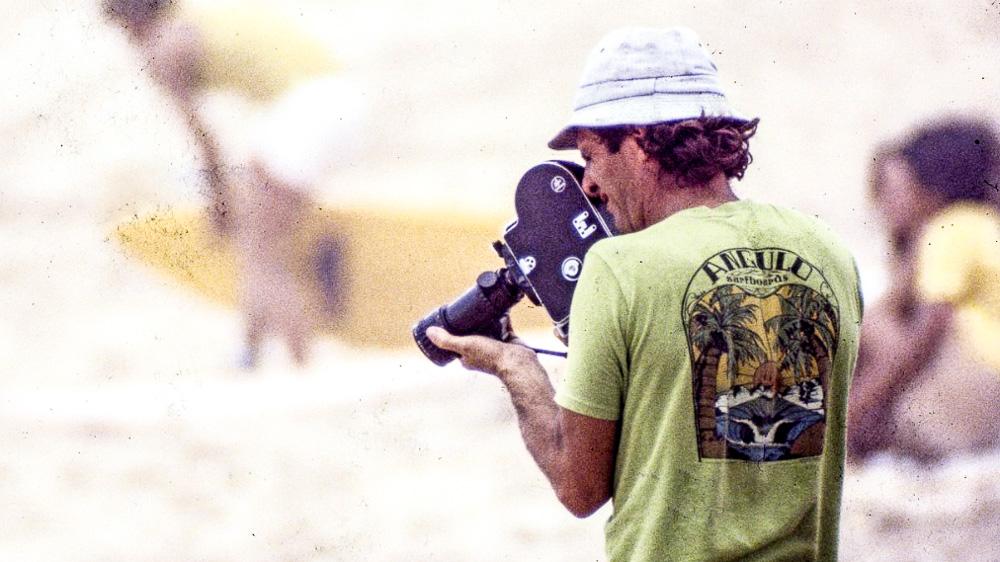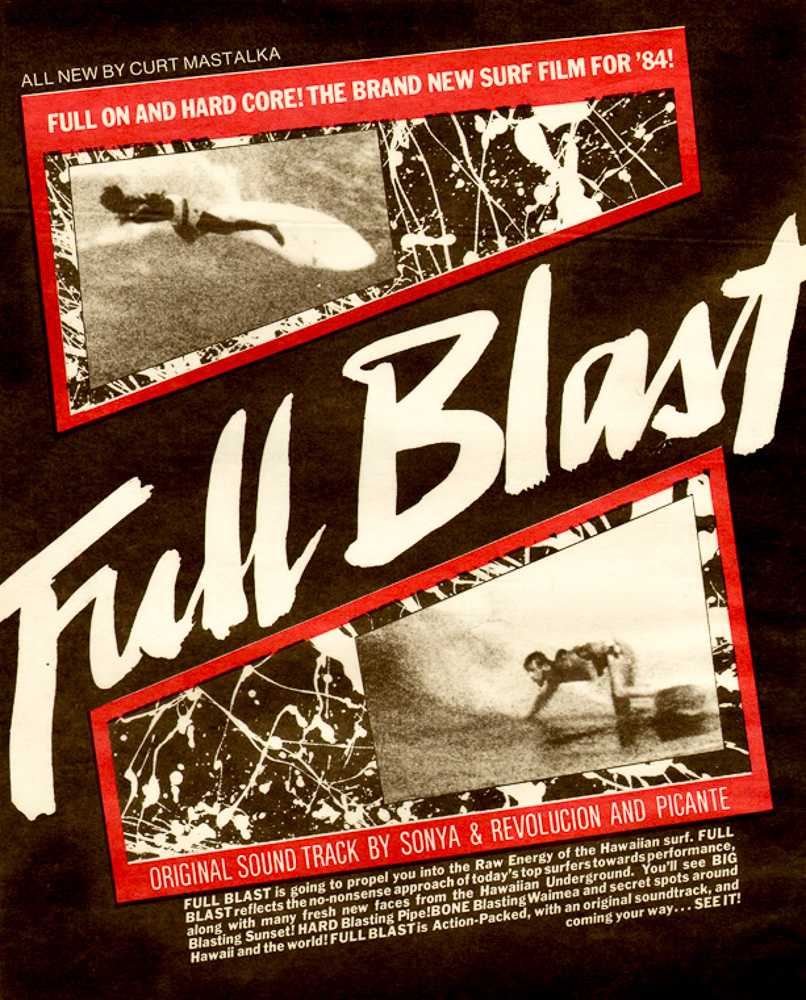"CAUGHT UP IN SURF MADNESS," STAR-BULLETIN FEATURE ON FILMMAKER CURT MASTALKA (1983)

Greg Ambrose' feature on surf filmmaker Curt Mastalka ran in the November 8, 1983, edition of the Honolulu Star- Bulletin. This version has been slightly edited.
* * *
Keep your eyes on the telephone poles at the North Shore. They'll reveal whether Island filmmaker Curt Mastalka has been practicing his craft. Every three years or so Mastalka asks himself whether he’s ready to submit himself once again to the exquisite torture of making another surf film. If the answer is "yes," telephone poles from Velzyland to Haleiwa will be plastered with colorful posters, tantalizing invitations to come view Mastalka's private dreams once again.
Poles these days are sporting lurid posters promoting Full Blast, Mastalka's latest movie.
The decision to film or not to film is not made lightly “You have to be a masochist to make surf films—nobody has stayed in the business.” Mastalka said. “It takes too much time to get the footage. To get good footage is a miracle.”
Innumerable hours spent crouched behind a camera lens on the beach are only a small part of the process. “I’ve been living like a hermit getting this film together." Mastalka said. He has spent the past few months locked in his house near Waimea Bay editing three years' worth of surfing footage. He emerges blinking from his lair only to run film-related errands into town.
The final process is so arduous that he took vacation from his job with Lockheed Air Terminal at Honolulu International to devote all his time to the film.

The madness started just about the same time Mastalka began surfing, in 1960. Though he has been living in Hawaii for 27 years, Mastalka, 44, didn’t start surfing until the relatively late age of 21.
His first film, in 1961, was as crude as his equipment, an old 8mm camera. But the footage he took of his surfing buddies paid off: 50 cents a head in Foster Village, for a $50 profit. Mastakla knew he was onto something.
At first he was more interested in surfing than filmmaking, and in 1964 he moved to the North Shore to live with other surf bums moving from house to house. He settled into a place in front of the Pipeline, where pro surfer Gerry Lopez’s massive beachfront mansion now looms. Mastalka's cottage became a headquarters for famous transient surfers. But then came a fateful move to a house behind surf filmmaker Vai Valentine’s house at Sunset Beach.
Valentine rekindled Mastalka’s interest in movies. Valentine used to bring 16mm surf film to Mastalka’s house to show. Mastalka spent hours in Valentine’s editing room; in a flash of insight, Mastalka thought ‘‘Gee, this isn't much different than 8mm.
“When I realized that, I went to get a bank loan—but no deal. So I sold my car and bought an old VW Bug and used the rest of the money to help pay for equipment."
Thus began an adventure in 16mm surf movies that has never quite made Mastalka rich. "Making money was never in my mind," he said. It’s filmmaking itself that excites him. Lucky for him, too, because from his first movie, Hawaii's Own in 1967, to Sundance in 1976, Mastalka’s films have had a tradition of losing money.
"I figure it cost me $1 a head to show Sundance," he said wryly. "When I started, I never thought of money. This time I want to make some money—but I’m also a masochist, I enjoy the stress and abuse."
The crude equipment of yesterday is long gone. Now Mastalka shoots the action with a Century lens, a thoroughbred in its class His cinematography has become more sophisticated, too. The meticulous way Mastalka crafts his movies is an extension of his previous passion—building and flying radio controlled models. Without attention to detail, they crash.
Mastaika believes he has an advantage over many surf filmmakers—he surfs himself. This gives him a clearer sense of the ocean and its moods and a perception of surfers' special interaction with the ocean.
It can cause problems, too. He has missed many photogenic days because he went surfing instead.
Mastalka has a straight job for money and makes films as a hobby. "I once quit my job to make films," he said, "and it was a terrible idea." His hobby became his job and was too much work. “You end up not being your own boss."
But the dilemma, to surf or film, remains "I do sacrifice a lot, by not surfing, to gel footage. But I try to surf when the waves aren't as photogenic."
Most of the footage for Mastalka’s movies is the result of tedious hours on the beach, hunched behind the lens. But serendipity can lend a hand. At a party in Pupukea last winter, Mastalka was stunned by some of the best footage of surf in Java he had ever seen. Queries revealed that Brazilian cameraman Sergio Richer was responsible.
Mastalka was keen to get the film for his movie and approached Richer. Delighted at the prospect of having his footage in Mastalka's film, Richer struck a deal. Unfortunately, not long after, while Mastalka was skiing on the Mainland, Richer was killed during a surf session at Laniakea. [Note: Richer bled to death after his board's fin sliced an artery in his leg.]
Richer's friends remembered the bargain, however, and the footage is now an exotic segment in Mastalka's mostly-Hawaiian surf film.
Near the end of this latest ordeal, with a print of Full Blast hot in his hands and favorable reviews from anonymous surf rats ringing in his head. Mastalka is wired with excitement. Words tumble out. He fidgets, tapping his car keys to some unheard rhythm, barely able to contain his excitement.
"The movie came out exactly as I had planned and hoped," he said. "I've gone back to the basics in Full Blast, to get the feeling where kids come out of the theater and say, ‘Let's go surfing,' instead of Wasn't that a beautiful film?'
"A lot of modern surf filmmakers boast that they made their film in 90 days, and it looks like it," he said. Full Blast is the result of surf action from the past three years.
Mastaika's films are personal to him, more than just an assemblage of incredible surfing action. "Your films are your life, your scrapbook," he said. "As you get older, the memories are there, but you're not sure if they’re real or not. It slips through your fingers. Movies help keep reality from slipping away."
Mastalka hasn't been surfing as much as he'd like lately, but after Full Blast premieres in Hawaii and heads for showings in Australia and the Mainland, "I have nothing to do but surf," he said.
Until next time.
[Photo of Mastalka by Gordhino]